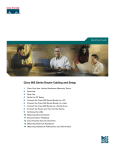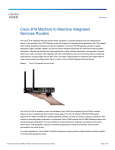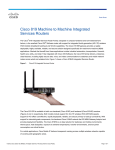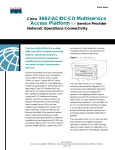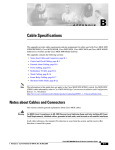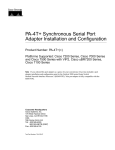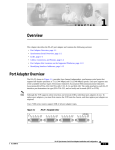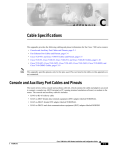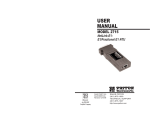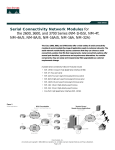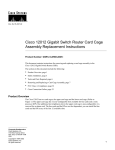Download Cisco Systems 805 Network Router User Manual
Transcript
Cisco 805 Router Hardware Installation Guide Corporate Headquarters Cisco Systems, Inc. 170 West Tasman Drive San Jose, CA 95134-1706 USA http://www.cisco.com Tel: 408 526-4000 800 553-NETS (6387) Fax: 408 526-4100 Customer Order Number: DOC-786372= Text Part Number: 78-6372-02 THE SPECIFICATIONS AND INFORMATION REGARDING THE PRODUCTS IN THIS MANUAL ARE SUBJECT TO CHANGE WITHOUT NOTICE. ALL STATEMENTS, INFORMATION, AND RECOMMENDATIONS IN THIS MANUAL ARE BELIEVED TO BE ACCURATE BUT ARE PRESENTED WITHOUT WARRANTY OF ANY KIND, EXPRESS OR IMPLIED. USERS MUST TAKE FULL RESPONSIBILITY FOR THEIR APPLICATION OF ANY PRODUCTS. THE SOFTWARE LICENSE AND LIMITED WARRANTY FOR THE ACCOMPANYING PRODUCT ARE SET FORTH IN THE INFORMATION PACKET THAT SHIPPED WITH THE PRODUCT AND ARE INCORPORATED HEREIN BY THIS REFERENCE. IF YOU ARE UNABLE TO LOCATE THE SOFTWARE LICENSE OR LIMITED WARRANTY, CONTACT YOUR CISCO REPRESENTATIVE FOR A COPY. The following information is for FCC compliance of Class A devices: This equipment has been tested and found to comply with the limits for a Class A digital device, pursuant to part 15 of the FCC rules. These limits are designed to provide reasonable protection against harmful interference when the equipment is operated in a commercial environment. This equipment generates, uses, and can radiate radio-frequency energy and, if not installed and used in accordance with the instruction manual, may cause harmful interference to radio communications. Operation of this equipment in a residential area is likely to cause harmful interference, in which case users will be required to correct the interference at their own expense. The following information is for FCC compliance of Class B devices: The equipment described in this manual generates and may radiate radio-frequency energy. If it is not installed in accordance with Cisco’s installation instructions, it may cause interference with radio and television reception. This equipment has been tested and found to comply with the limits for a Class B digital device in accordance with the specifications in part 15 of the FCC rules. These specifications are designed to provide reasonable protection against such interference in a residential installation. However, there is no guarantee that interference will not occur in a particular installation. Modifying the equipment without Cisco’s written authorization may result in the equipment no longer complying with FCC requirements for Class A or Class B digital devices. In that event, your right to use the equipment may be limited by FCC regulations, and you may be required to correct any interference to radio or television communications at your own expense. You can determine whether your equipment is causing interference by turning it off. If the interference stops, it was probably caused by the Cisco equipment or one of its peripheral devices. If the equipment causes interference to radio or television reception, try to correct the interference by using one or more of the following measures: • Turn the television or radio antenna until the interference stops. • Move the equipment to one side or the other of the television or radio. • Move the equipment farther away from the television or radio. • Plug the equipment into an outlet that is on a different circuit from the television or radio. (That is, make certain the equipment and the television or radio are on circuits controlled by different circuit breakers or fuses.) Modifications to this product not authorized by Cisco Systems, Inc. could void the FCC approval and negate your authority to operate the product. The Cisco implementation of TCP header compression is an adaptation of a program developed by the University of California, Berkeley (UCB) as part of UCB’s public domain version of the UNIX operating system. All rights reserved. Copyright © 1981, Regents of the University of California. NOTWITHSTANDING ANY OTHER WARRANTY HEREIN, ALL DOCUMENT FILES AND SOFTWARE OF THESE SUPPLIERS ARE PROVIDED “AS IS” WITH ALL FAULTS. CISCO AND THE ABOVE-NAMED SUPPLIERS DISCLAIM ALL WARRANTIES, EXPRESSED OR IMPLIED, INCLUDING, WITHOUT LIMITATION, THOSE OF MERCHANTABILITY, FITNESS FOR A PARTICULAR PURPOSE AND NONINFRINGEMENT OR ARISING FROM A COURSE OF DEALING, USAGE, OR TRADE PRACTICE. IN NO EVENT SHALL CISCO OR ITS SUPPLIERS BE LIABLE FOR ANY INDIRECT, SPECIAL, CONSEQUENTIAL, OR INCIDENTAL DAMAGES, INCLUDING, WITHOUT LIMITATION, LOST PROFITS OR LOSS OR DAMAGE TO DATA ARISING OUT OF THE USE OR INABILITY TO USE THIS MANUAL, EVEN IF CISCO OR ITS SUPPLIERS HAVE BEEN ADVISED OF THE POSSIBILITY OF SUCH DAMAGES. CCSP, CCVP, the Cisco Square Bridge logo, Follow Me Browsing, and StackWise are trademarks of Cisco Systems, Inc.; Changing the Way We Work, Live, Play, and Learn, and iQuick Study are service marks of Cisco Systems, Inc.; and Access Registrar, Aironet, ASIST, BPX, Catalyst, CCDA, CCDP, CCIE, CCIP, CCNA, CCNP, Cisco, the Cisco Certified Internetwork Expert logo, Cisco IOS, Cisco Press, Cisco Systems, Cisco Systems Capital, the Cisco Systems logo, Cisco Unity, Empowering the Internet Generation, Enterprise/Solver, EtherChannel, EtherFast, EtherSwitch, Fast Step, FormShare, GigaDrive, GigaStack, HomeLink, Internet Quotient, IOS, IP/TV, iQ Expertise, the iQ logo, iQ Net Readiness Scorecard, LightStream, Linksys, MeetingPlace, MGX, the Networkers logo, Networking Academy, Network Registrar, Packet, PIX, Post-Routing, Pre-Routing, ProConnect, RateMUX, ScriptShare, SlideCast, SMARTnet, StrataView Plus, TeleRouter, The Fastest Way to Increase Your Internet Quotient, and TransPath are registered trademarks of Cisco Systems, Inc. and/or its affiliates in the United States and certain other countries. All other trademarks mentioned in this document or Website are the property of their respective owners. The use of the word partner does not imply a partnership relationship between Cisco and any other company. (0502R) Cisco 805 Router Hardware Installation Guide Copyright © 2005 Cisco Systems, Inc. All rights reserved. C ON T E N T S About This Guide Audience v v Organization v Conventions vi Terms and Acronyms viii Related Documentation Chapter 1 Product Overview Features Chapter 2 1-1 1-1 Front Panel 1-3 Back Panel 1-3 LEDs xi 1-5 Installing the Cisco 805 Router 2-1 Safety 2-1 Warnings 2-1 ESD 2-3 Required Equipment Unpacking the Box 2-4 2-5 Installing the Router 2-6 Connecting an Ethernet Device 2-6 Connecting a Hub 2-7 Connecting a Server, PC, or Workstation Connecting a Serial Device 2-10 Connecting a Terminal or PC 2-12 Connecting the Power Supply 2-13 Mounting the Router 2-14 Mounting the Router on a Table 2-14 Mounting the Router on a Wall 2-14 Verifying Installation 2-17 2-8 Contents iii Where to Go Next Chapter 3 Troubleshooting 2-17 3-1 Problems During First Startup 3-2 Problems After Router is Running 3-3 Before You Call Your Cisco Reseller Appendix A Selecting a Serial Cable 3-5 A-1 How to Select a Serial Cable A-1 DTE or DCE A-2 Signaling Standards A-4 Connector Gender A-4 Serial Connection Example A-5 Serial Cable Part Numbers A-6 Appendix B Technical Specifications B-1 Appendix C Connector and Cable Specifications Connector Specifications Cable Specifications Index iv Cisco 805 Router Hardware Installation Guide C-4 C-1 C-1 About This Guide This preface discusses the audience, organization, conventions, and terms and acronyms used in this guide. It also discusses related documentation and how to access electronic documentation. Audience This guide is intended for service technicians who have no experience installing routers. The goal of these technicians is to connect the router to the network as quickly as possible. This guide provides conceptual information on topics, such as serial cables, that you need to understand to successfully install your router. Conceptual information is usually in a separate section or appendix, such as Appendix A, “Selecting a Serial Cable,” so that technicians who are not interested or already understand the topic can skip this information. Organization This guide contains the following information: • • Product Overview—Describes the Cisco 805 router and its features. • Troubleshooting—Describes problems with the router and how to identify and solve them. Installing the Cisco 805 Router—Provides information on safety, required equipment, unpacking the box, connecting and mounting the router, and verifying the router connections. About This Guide v Conventions • Selecting a Serial Cable—Explains how to select a serial cable to connect your serial device to the router serial port. It also provides Cisco part numbers for cables that you can order. • Technical Specifications—Provides physical dimensions, environmental operating ranges, and power specifications for the router. • Connector and Cable Specifications—Contains port connector pinouts and specifications for cables that you might need to provide. • A wall-mount template is provided at the back of this manual. For more information, see the “Mounting the Router on a Wall” section in Chapter 2, “Installing the Cisco 805 Router.” Conventions This section describes the conventions used in this guide. Note Means reader take note. Notes contain helpful suggestions or references to additional information and material. Caution This symbol means reader be careful. In this situation, you might do something that could result in equipment damage or loss of data. Warning This warning symbol means danger. You are in a situation that could cause bodily injury. Before you work on any equipment, be aware of the hazards involved with electrical circuitry and be familiar with standard practices for preventing accidents. To see translations of the warnings that appear in this publication, refer to the Regulatory Compliance and Safety Information document that accompanied this device. Waarschuwing Dit waarschuwingssymbool betekent gevaar. U verkeert in een situatie die lichamelijk letsel kan veroorzaken. Voordat u aan enige apparatuur gaat werken, dient u zich bewust te zijn van de bij elektrische schakelingen betrokken risico's en dient u op de hoogte te zijn van standaard maatregelen om ongelukken te voorkomen. Voor vertalingen vi Cisco 805 Router Hardware Installation Guide Conventions van de waarschuwingen die in deze publicatie verschijnen, kunt u het document Regulatory Compliance and Safety Information (Informatie over naleving van veiligheids- en andere voorschriften) raadplegen dat bij dit toestel is ingesloten. Varoitus Tämä varoitusmerkki merkitsee vaaraa. Olet tilanteessa, joka voi johtaa ruumiinvammaan. Ennen kuin työskentelet minkään laitteiston parissa, ota selvää sähkökytkentöihin liittyvistä vaaroista ja tavanomaisista onnettomuuksien ehkäisykeinoista. Tässä julkaisussa esiintyvien varoitusten käännökset löydät laitteen mukana olevasta Regulatory Compliance and Safety Information -kirjasesta (määräysten noudattaminen ja tietoa turvallisuudesta). Attention Ce symbole d'avertissement indique un danger. Vous vous trouvez dans une situation pouvant causer des blessures ou des dommages corporels. Avant de travailler sur un équipement, soyez conscient des dangers posés par les circuits électriques et familiarisez-vous avec les procédures couramment utilisées pour éviter les accidents. Pour prendre connaissance des traductions d’avertissements figurant dans cette publication, consultez le document Regulatory Compliance and Safety Information (Conformité aux règlements et consignes de sécurité) qui accompagne cet appareil. Warnung Dieses Warnsymbol bedeutet Gefahr. Sie befinden sich in einer Situation, die zu einer Körperverletzung führen könnte. Bevor Sie mit der Arbeit an irgendeinem Gerät beginnen, seien Sie sich der mit elektrischen Stromkreisen verbundenen Gefahren und der Standardpraktiken zur Vermeidung von Unfällen bewußt. Übersetzungen der in dieser Veröffentlichung enthaltenen Warnhinweise finden Sie im Dokument Regulatory Compliance and Safety Information (Informationen zu behördlichen Vorschriften und Sicherheit), das zusammen mit diesem Gerät geliefert wurde. Avvertenza Questo simbolo di avvertenza indica un pericolo. La situazione potrebbe causare infortuni alle persone. Prima di lavorare su qualsiasi apparecchiatura, occorre conoscere i pericoli relativi ai circuiti elettrici ed essere al corrente delle pratiche standard per la prevenzione di incidenti. La traduzione delle avvertenze riportate in questa pubblicazione si trova nel documento Regulatory Compliance and Safety Information (Conformità alle norme e informazioni sulla sicurezza) che accompagna questo dispositivo. Advarsel Dette varselsymbolet betyr fare. Du befinner deg i en situasjon som kan føre til personskade. Før du utfører arbeid på utstyr, må du vare oppmerksom på de faremomentene som elektriske kretser innebærer, samt gjøre deg kjent med vanlig praksis når det gjelder å unngå ulykker. Hvis du vil se oversettelser av de advarslene som finnes i denne publikasjonen, kan du se i dokumentet Regulatory Compliance and Safety Information (Overholdelse av forskrifter og sikkerhetsinformasjon) som ble levert med denne enheten. About This Guide vii Terms and Acronyms Aviso Este símbolo de aviso indica perigo. Encontra-se numa situação que lhe poderá causar danos físicos. Antes de começar a trabalhar com qualquer equipamento, familiarizese com os perigos relacionados com circuitos eléctricos, e com quaisquer práticas comuns que possam prevenir possíveis acidentes. Para ver as traduções dos avisos que constam desta publicação, consulte o documento Regulatory Compliance and Safety Information (Informação de Segurança e Disposições Reguladoras) que acompanha este dispositivo. ¡Advertencia! Este símbolo de aviso significa peligro. Existe riesgo para su integridad física. Antes de manipular cualquier equipo, considerar los riesgos que entraña la corriente eléctrica y familiarizarse con los procedimientos estándar de prevención de accidentes. Para ver una traducción de las advertencias que aparecen en esta publicación, consultar el documento titulado Regulatory Compliance and Safety Information (Información sobre seguridad y conformidad con las disposiciones reglamentarias) que se acompaña con este dispositivo. Varning! Denna varningssymbol signalerar fara. Du befinner dig i en situation som kan leda till personskada. Innan du utför arbete på någon utrustning måste du vara medveten om farorna med elkretsar och känna till vanligt förfarande för att förebygga skador. Se förklaringar av de varningar som förkommer i denna publikation i dokumentet Regulatory Compliance and Safety Information (Efterrättelse av föreskrifter och säkerhetsinformation), vilket medföljer denna anordning. Terms and Acronyms This section describes terms and acronyms that are used in this guide. 10BaseT The 10-Mbps baseband Ethernet specification that uses two pairs of twisted-pair cabling (Category 3, 4, or 5): one pair for transmitting data and the other for receiving data. asynchronous modem Connect this device to router serial port for dial-up connection. carrier detect Signal that indicates whether the serial interface is active. viii Cisco 805 Router Hardware Installation Guide Terms and Acronyms crossover Ethernet cable A cable that wires a pin to its opposite pin; for example, Receive+ is wired to Transmit+. This cable connects two similar devices, such as a data terminal equipment (DTE) and data communications equipment (DCE) device. CSU/DSU Channel service unit/data service unit. Connect this type of device to router serial port for synchronous leased-line, Frame Relay, or X.25 connection. DCE Data communications equipment. This type of equipment provides a physical connection to the network and forwards traffic. A synchronous DCE also provides a clocking signal used to synchronize data transmission between DCE and DTE devices, while an asynchronous DCE does not provide a clocking signal. For more information, see the “DTE or DCE” section in Appendix A, “Selecting a Serial Cable.” DTE Data terminal equipment. This type of equipment connects to a data network through a DCE device, such as a modem, and typically uses clocking signals generated by the DCE. For more information, see the “DTE or DCE” section in Appendix A, “Selecting a Serial Cable.” DRAM Dynamic RAM. Dynamic RAM that stores information that must be refreshed periodically in capacitors. Flash memory The nonvolatile storage that can be electrically erased and reprogrammed so that data can be stored, booted, and rewritten as necessary. HUB/NO HUB button With this button, you can connect hubs, servers, PCs, and workstations using the yellow Ethernet (straight-through) cable instead of using a crossover Ethernet cable, which you would need to supply. This button identifies the device that you connect to the router Ethernet port using the yellow Ethernet cable. Setting the button to HUB (in) indicates that you are connecting a hub; setting the button to NO HUB (out) indicates that you are connecting a server, PC, or workstation. For information on how the setting of an About This Guide ix Terms and Acronyms equivalent hub button can affect the setting of this router button, refer to the “Connecting an Ethernet Device” section in Chapter 2, “Installing the Cisco 805 Router.” link Indicates that a connection between the router and an Ethernet device exists. MDI Media-dependent interface. A port on a Ethernet network device used to connect the device to the Ethernet network, usually through a hub or switch. MDI-X Media-dependent interface, crossover. A port on an Ethernet hub, such as the Cisco 1528 Micro Hub 10/100, that connects the Ethernet network devices through the MDI port to create a network. NIC Network interface card. A board that provides network communication capabilities to and from a computer system. Also called an adapter. SELV Safety extra-low voltage. A secondary circuit that under normal conditions has a voltage less than 42.4V peak or 42 Vdc. Under a single fault condition, this circuit should not exceed these values for longer than 0.2 seconds and should not exceed 71V peak or 120 Vdc. straight-through Ethernet cable A cable that wires a pin to its equivalent pin. This cable typically connects a router to a hub. A straight-through Ethernet cable is the most common cable used. TNV Telecommunications network voltage. A secondary circuit that under normal operating conditions, carriers telecommunication signals. Telecommunications signals are a steady state, varying amplitude, or intermittent voltage or current intended for use on a telecommunications network. A telecommunications network is considered a metallically terminated circuit intended to carry telecommunication signals for voice, x Cisco 805 Router Hardware Installation Guide Related Documentation data, or other communication. These networks might be publicly or privately owned. They might be subjected to overvoltages due to atmospheric discharges or power line failures. Related Documentation In addition to this Cisco 805 Router Hardware Installation Guide, the Cisco 805 documentation set includes the following: • • Quick Start Guide—Setting Up the Cisco 805 Router Cisco 805 Router Software Configuration Guide Obtaining Documentation Cisco documentation and additional literature are available on Cisco.com. Cisco also provides several ways to obtain technical assistance and other technical resources. These sections explain how to obtain technical information from Cisco Systems. Cisco.com You can access the most current Cisco documentation at this URL: http://www.cisco.com/univercd/home/home.htm You can access the Cisco website at this URL: http://www.cisco.com You can access international Cisco websites at this URL: http://www.cisco.com/public/countries_languages.shtml About This Guide xi Related Documentation Documentation DVD Cisco documentation and additional literature are available in a Documentation DVD package, which may have shipped with your product. The Documentation DVD is updated regularly and may be more current than printed documentation. The Documentation DVD package is available as a single unit. Registered Cisco.com users (Cisco direct customers) can order a Cisco Documentation DVD (product number DOC-DOCDVD=) from the Ordering tool or Cisco Marketplace. Cisco Ordering tool: http://www.cisco.com/en/US/partner/ordering/ Cisco Marketplace: http://www.cisco.com/go/marketplace/ Ordering Documentation You can find instructions for ordering documentation at this URL: http://www.cisco.com/univercd/cc/td/doc/es_inpck/pdi.htm You can order Cisco documentation in these ways: • Registered Cisco.com users (Cisco direct customers) can order Cisco product documentation from the Ordering tool: http://www.cisco.com/en/US/partner/ordering/ • Nonregistered Cisco.com users can order documentation through a local account representative by calling Cisco Systems Corporate Headquarters (California, USA) at 408 526-7208 or, elsewhere in North America, by calling 1 800 553-NETS (6387). Documentation Feedback You can send comments about technical documentation to [email protected]. xii Cisco 805 Router Hardware Installation Guide Related Documentation You can submit comments by using the response card (if present) behind the front cover of your document or by writing to the following address: Cisco Systems Attn: Customer Document Ordering 170 West Tasman Drive San Jose, CA 95134-9883 We appreciate your comments. Cisco Product Security Overview Cisco provides a free online Security Vulnerability Policy portal at this URL: http://www.cisco.com/en/US/products/products_security_vulnerability_policy.html From this site, you can perform these tasks: • Report security vulnerabilities in Cisco products. • Obtain assistance with security incidents that involve Cisco products. • Register to receive security information from Cisco. A current list of security advisories and notices for Cisco products is available at this URL: http://www.cisco.com/go/psirt If you prefer to see advisories and notices as they are updated in real time, you can access a Product Security Incident Response Team Really Simple Syndication (PSIRT RSS) feed from this URL: http://www.cisco.com/en/US/products/products_psirt_rss_feed.html Reporting Security Problems in Cisco Products Cisco is committed to delivering secure products. We test our products internally before we release them, and we strive to correct all vulnerabilities quickly. If you think that you might have identified a vulnerability in a Cisco product, contact PSIRT: • Emergencies — [email protected] • Nonemergencies — [email protected] About This Guide xiii Related Documentation Tip We encourage you to use Pretty Good Privacy (PGP) or a compatible product to encrypt any sensitive information that you send to Cisco. PSIRT can work from encrypted information that is compatible with PGP versions 2.x through 8.x. Never use a revoked or an expired encryption key. The correct public key to use in your correspondence with PSIRT is the one that has the most recent creation date in this public key server list: http://pgp.mit.edu:11371/pks/lookup?search=psirt%40cisco.com&op=index&exact=on In an emergency, you can also reach PSIRT by telephone: • 1 877 228-7302 • 1 408 525-6532 Obtaining Technical Assistance For all customers, partners, resellers, and distributors who hold valid Cisco service contracts, Cisco Technical Support provides 24-hour-a-day, award-winning technical assistance. The Cisco Technical Support Website on Cisco.com features extensive online support resources. In addition, Cisco Technical Assistance Center (TAC) engineers provide telephone support. If you do not hold a valid Cisco service contract, contact your reseller. Cisco Technical Support Website The Cisco Technical Support Website provides online documents and tools for troubleshooting and resolving technical issues with Cisco products and technologies. The website is available 24 hours a day, 365 days a year, at this URL: http://www.cisco.com/techsupport Access to all tools on the Cisco Technical Support Website requires a Cisco.com user ID and password. If you have a valid service contract but do not have a user ID or password, you can register at this URL: http://tools.cisco.com/RPF/register/register.do xiv Cisco 805 Router Hardware Installation Guide Related Documentation Note Use the Cisco Product Identification (CPI) tool to locate your product serial number before submitting a web or phone request for service. You can access the CPI tool from the Cisco Technical Support Website by clicking the Tools & Resources link under Documentation & Tools. Choose Cisco Product Identification Tool from the Alphabetical Index drop-down list, or click the Cisco Product Identification Tool link under Alerts & RMAs. The CPI tool offers three search options: by product ID or model name; by tree view; or for certain products, by copying and pasting show command output. Search results show an illustration of your product with the serial number label location highlighted. Locate the serial number label on your product and record the information before placing a service call. Submitting a Service Request Using the online TAC Service Request Tool is the fastest way to open S3 and S4 service requests. (S3 and S4 service requests are those in which your network is minimally impaired or for which you require product information.) After you describe your situation, the TAC Service Request Tool provides recommended solutions. If your issue is not resolved using the recommended resources, your service request is assigned to a Cisco TAC engineer. The TAC Service Request Tool is located at this URL: http://www.cisco.com/techsupport/servicerequest For S1 or S2 service requests or if you do not have Internet access, contact the Cisco TAC by telephone. (S1 or S2 service requests are those in which your production network is down or severely degraded.) Cisco TAC engineers are assigned immediately to S1 and S2 service requests to help keep your business operations running smoothly. To open a service request by telephone, use one of the following numbers: Asia-Pacific: +61 2 8446 7411 (Australia: 1 800 805 227) EMEA: +32 2 704 55 55 USA: 1 800 553-2447 For a complete list of Cisco TAC contacts, go to this URL: http://www.cisco.com/techsupport/contacts About This Guide xv Related Documentation Definitions of Service Request Severity To ensure that all service requests are reported in a standard format, Cisco has established severity definitions. Severity 1 (S1)—Your network is “down,” or there is a critical impact to your business operations. You and Cisco will commit all necessary resources around the clock to resolve the situation. Severity 2 (S2)—Operation of an existing network is severely degraded, or significant aspects of your business operation are negatively affected by inadequate performance of Cisco products. You and Cisco will commit full-time resources during normal business hours to resolve the situation. Severity 3 (S3)—Operational performance of your network is impaired, but most business operations remain functional. You and Cisco will commit resources during normal business hours to restore service to satisfactory levels. Severity 4 (S4)—You require information or assistance with Cisco product capabilities, installation, or configuration. There is little or no effect on your business operations. Obtaining Additional Publications and Information Information about Cisco products, technologies, and network solutions is available from various online and printed sources. • Cisco Marketplace provides a variety of Cisco books, reference guides, and logo merchandise. Visit Cisco Marketplace, the company store, at this URL: http://www.cisco.com/go/marketplace/ • Cisco Press publishes a wide range of general networking, training and certification titles. Both new and experienced users will benefit from these publications. For current Cisco Press titles and other information, go to Cisco Press at this URL: http://www.ciscopress.com • Packet magazine is the Cisco Systems technical user magazine for maximizing Internet and networking investments. Each quarter, Packet delivers coverage of the latest industry trends, technology breakthroughs, and Cisco products and solutions, as well as network deployment and xvi Cisco 805 Router Hardware Installation Guide Related Documentation troubleshooting tips, configuration examples, customer case studies, certification and training information, and links to scores of in-depth online resources. You can access Packet magazine at this URL: http://www.cisco.com/packet • iQ Magazine is the quarterly publication from Cisco Systems designed to help growing companies learn how they can use technology to increase revenue, streamline their business, and expand services. The publication identifies the challenges facing these companies and the technologies to help solve them, using real-world case studies and business strategies to help readers make sound technology investment decisions. You can access iQ Magazine at this URL: http://www.cisco.com/go/iqmagazine • Internet Protocol Journal is a quarterly journal published by Cisco Systems for engineering professionals involved in designing, developing, and operating public and private internets and intranets. You can access the Internet Protocol Journal at this URL: http://www.cisco.com/ipj • World-class networking training is available from Cisco. You can view current offerings at this URL: http://www.cisco.com/en/US/learning/index.html About This Guide xvii Related Documentation xviii Cisco 805 Router Hardware Installation Guide CHAPTER 1 Product Overview The Cisco 805 router can connect a remote office to a corporate office or a small professional office to an Internet service provider (ISP). In the remote-office-to-corporate-office network, the remote office is typically a small professional office that is part of a larger corporation, such as a real estate office. Although a majority of its data might exist at the remote office itself, the remote office might also need to exchange data with its larger corporate office. As a result, the remote office needs a connection to the corporate office. In the small-office-to-ISP network, the small office is typically a small, independent professional office, such as a small architectural firm that needs to access information from the Internet. Features Table 1-1 summarizes the features of the Cisco 805 router. Table 1-1 Cisco 805 Feature Summary Feature Description 10BaseT Ethernet port Provides connection to a 10BaseT (10 Mbps) Ethernet network. Compatible with a 10/100-Mbps device. Serial port Provides connection to EIA/TIA-232, EIA/TIA-449, EIA/TIA-530, EIA/TIA-530A, X.21, and V.35 data terminal equipment (DTE) or data communications equipment (DCE). RJ-45 Console port Provides connection to terminal or PC for software configuration and for router troubleshooting. Product Overview 1-1 Features Table 1-1 Feature Description Flash memory Router provides 4 MB of Flash memory.1 Dynamic RAM (DRAM) Router provides 8 MB of DRAM.1 Ease of installation Color-coded ports and cables reduce the chance of error. Cisco IOS software Router supports a subset of Cisco IOS software. Cisco 805 Fast Step software Provides a Windows 95, Windows 98, and Windows NT software tool for basic Cisco 805 configuration. Cable lock Provides a way to physically secure router. Locking power connector Locks power connector in place. Wall-mount feature Brackets on router bottom provide a way to mount router on wall or vertical surface. 1 1-2 Cisco 805 Feature Summary (continued) An additional 4 or 8 MB of Flash memory and DRAM can be added at the factory or later. You can order upgrade kits and have qualified personnel add the memory. The Cisco product number for the 4-MB Flash memory upgrade kit is MEM805-4U8F, for the 8-MB Flash memory upgrade kit it is MEM805-4U12F, for the 4-MB DRAM upgrade kit it is MEM805-8U12D, and for the 8-MB DRAM upgrade kit it is MEM805-8U16D. (Because of the height of the actual DRAM component, you must order the additional DRAM from Cisco.) Cisco 805 Router Hardware Installation Guide Front Panel Front Panel Figure 1-1 describes the Cisco 805 front panel. Figure 1-1 Cisco 805 Front Panel WAN LEDs Indicate packets are sent to or received from serial port. 17281 LAN LEDs Indicate packets are sent to or OK LED received from Indicates Ethernet port. router has power. For more details, see the “LEDs” section later in this chapter. Back Panel Figure 1-2 describes the Cisco 805 back panel. If the symbol of suitability ( ) appears above a port, you can connect the port directly to a public network that follows the European Union standards. If the symbol of suitability with an overlaid cross ( ) appears above a port, you must not connect the port to a public network that follows the European Union standards. Connecting the port to this type of public network can cause severe injury or damage your router. Product Overview 1-3 Back Panel Figure 1-2 Cisco 805 Back Panel LINK LED Indicates state of Ethernet port. On when connected. Ethernet port Connects Ethernet network device. HUB NO HU B ETHERN ET CONSOL 10 BASE Cable lock Physically secures router. E T Power switch l = On = Standby or no power output Cisco 80 5 SERIAL Console port Connects PC or terminal. HUB/NO HUB button (for Ethernet port) Identifies device connected to Ethernet port and determines Ethernet cable. 17282 LINK Serial port Connects modem or CSU/DSU. Locking power connector Connects power supply. With the HUB/NO HUB button, you can connect hubs, servers, PCs, and workstations using the yellow Ethernet (straight-through) cable instead of using a crossover Ethernet cable, which you would need to supply. This button identifies the device that you connect to the router Ethernet port using the yellow Ethernet cable. Setting the button to HUB (in) indicates that you are connecting a hub; setting the button to NO HUB (out) indicates that you are connecting a server, PC, or workstation. The default setting of this button is HUB. If you reset the button to NO HUB, the router Ethernet connector crosses over the signals transmitted to and received from the yellow Ethernet cable. For information on how the setting of an equivalent hub button can affect the setting of this router button, refer to the “Connecting an Ethernet Device” section in Chapter 2, “Installing the Cisco 805 Router.” 1-4 Cisco 805 Router Hardware Installation Guide LEDs LEDs Table 1-2 summarizes the function of each LED. All LEDs are on the router front panel except for the LINK LED, which is on the router back panel. Table 1-2 LED Functions LED Corresponding Port/Component Color Function OK Power Green On when power is supplied to the router and when the router completes the self-test procedure and begins operating. LAN Ethernet Green On when the Ethernet interface is up. Off when the Ethernet interface has been shut down. RXD Ethernet Green Blinks when the Ethernet port receives a packet. Ethernet Green Blinks when the Ethernet port sends a packet. Serial Orange On when the serial interface is up and a carrier signal is detected. Off when a carrier signal is not detected. Serial Orange Blinks when the serial port receives a packet. Serial Orange Blinks when the serial port sends a packet. Ethernet Green On when Ethernet device is connected. Off when the connection has a problem. Refer to the Chapter 3, “Troubleshooting.” (Received) TXD (Transmitted) CD (Carrier detect) RXD (Received) TXD (Transmitted) LINK Product Overview 1-5 LEDs 1-6 Cisco 805 Router Hardware Installation Guide CHAPTER 2 Installing the Cisco 805 Router This chapter provides information on the following topics: • • • • • Safety Required Equipment Unpacking the Box Installing the Router Where to Go Next Safety This section contains information on warnings associated with using your router and on electrostatic discharge (ESD). Warnings Before installing the router, read the following warnings: Warning Only trained and qualified personnel should be allowed to install or replace this equipment. Warning Read the installation instructions before you connect the system to its power source. Installing the Cisco 805 Router 2-1 Safety Warning Before working on a system that has a standby/on switch, turn the power to standby and unplug the power cord. Warning Before working on equipment that is connected to power lines, remove jewelry (including rings, necklaces, and watches). Metal objects will heat up when connected to power and ground and can cause serious burns or weld the metal object to the terminals. Warning Ultimate disposal of this product should be handled according to all national laws and regulations. Warning If the symbol of suitability with an overlaid cross ( ) appears above a port, you must not connect the port to a public network that follows the European Union standards. Connecting the port to this type of public network can cause severe injury or damage your router. Warning To avoid electric shock, do not connect safety extra-low voltage (SELV) circuits to telephone-network voltage (TNV) circuits. LAN ports contain SELV circuits, and WAN ports contain TNV circuits. Some LAN and WAN ports both use RJ-45 connectors. Use caution when connecting cables. Figure 2-1 shows the Cisco 805 router ports that include SELV circuits. For a definition of SELV and TNV, see “Terms and Acronyms” in “About this Guide.” 2-2 Cisco 805 Router Hardware Installation Guide ESD Figure 2-1 SELV Circuit Ports Includes SELV circuits LINK HUB NO HU B ETHERN ET CONSOL T Cisco 80 5 SERIAL 24848 10 BASE E ESD ESD is a transfer of electrostatic charge between bodies of different electrostatic potentials, such as an operator and a piece of electrical equipment. It occurs when electronic components are improperly handled, and it can damage equipment and impair electrical circuitry. Electrostatic discharge is more likely to occur with the combination of synthetic fibers and dry atmosphere. Always use the following ESD-prevention guidelines when removing and replacing components: • • Connect the chassis to earth ground with a wire that you provide. • • Do not touch any exposed contact pins or connector shells of uncabled router ports. Wear an ESD-preventive wrist strap that you provide, ensuring that it makes good skin contact. If cables are connected at one end only, do not touch the exposed pins at the unconnected end of the cable. Note This device is intended for use in residential and commercial environments only. Installing the Cisco 805 Router 2-3 Required Equipment Caution Periodically check the resistance value of the antistatic strap, which should be between 1 and 10 megohms (Mohms). Required Equipment You need to provide the following equipment: 2-4 • The hub, server, workstation, or PC that you plan to connect to the Ethernet port. The server, workstation, or PC must have a 10- or 10/100-Mbps network interface card (NIC). • The asynchronous modem or channel service unit/data service unit (CSU/DSU) that you plan to connect to the serial port. • The serial cable that connects the router to the serial device. For information on selecting and ordering the serial cable, refer to Appendix A, “Selecting a Serial Cable.” • The terminal or PC with which you plan to configure the software or troubleshoot the router. • If you plan to mount your router on a wall or other vertical surface, two number-six, 3/4-inch (M3.5 x 20 mm) screws. If the wall to which you plan to mount your router is drywall, you must also provide two hollow wall-anchors (1/8 inch with 5/16-inch drill bit or M3 with 8-mm drill bit) to secure the screws. Cisco 805 Router Hardware Installation Guide Unpacking the Box Unpacking the Box The items that come with your router are listed below. All these items are in the accessory kit that is inside the box that your router came in. If any of the items is missing or damaged, contact your customer service representative. • • • • • • • Power cord (black) Desktop power supply Console cable (light blue) DB-9-to-RJ-45 adapter for use with light blue console cable DB-25-to-RJ-45 adapter for use with light blue console cable Ethernet cable (yellow) Product documentation Note A serial cable does not ship with the router. For information on selecting and ordering the serial cable, refer to Appendix A, “Selecting a Serial Cable.” Installing the Cisco 805 Router 2-5 Installing the Router Installing the Router To install the router, perform the following tasks in the following order: 1 Connect an Ethernet device. 2 Connect a serial device. 3 Connect a terminal or PC (for software configuration or router troubleshooting). 4 Connect the power supply. 5 Mount the router. 6 Verify the router installation. Connecting an Ethernet Device You can connect the following devices to the Ethernet port: • • A hub A server, PC, or workstation with a 10- or 10/100-Mbps NIC Table 2-1 lists the Ethernet devices you can connect to the router with the yellow Ethernet cable and the appropriate settings of the router HUB/NO HUB button and the hub equivalent of the HUB/NO HUB button. The default setting of the router HUB/NO HUB button is HUB (in). 2-6 Cisco 805 Router Hardware Installation Guide Connecting an Ethernet Device Table 2-1 Connecting Ethernet Devices Router HUB/NO HUB Button Setting Hub Button Setting1 Hub with equivalent to router HUB/NO HUB button HUB (in) MDI (in) Hub with equivalent to router HUB/NO HUB button NO HUB (out) MDI-X (out) Hub without equivalent to router HUB/NO HUB button NO HUB (out) MDI-X (out) Server, PC, or workstation NO HUB (out) – Network Device Connected to Router 1 Hub vendors choose different names for the button controlling cable selection. This table uses the Cisco 1528 Micro Hub 10/100 with an MDI/MDI-X button as an example. Determine the button name and setting for your particular hub. Refer to your hub documentation for details. Connecting a Hub Before connecting a hub, refer to Table 2-1 to determine how to set the router HUB/NO HUB button and the hub equivalent of the HUB/NO HUB button if applicable. Follow the steps in Figure 2-3 to connect a hub. Installing the Cisco 805 Router 2-7 Installing the Router Figure 2-2 Connecting a Hub Cisco 805 router 1. Set HUB/NO HUB button. HUB LINK NO HUB ETHERN ET CONSOL E 10 BASE Cisco 80 5 T SERIAL 2. Connect yellow cable to yellow Ethernet port. Cisco 1528 Micro Hub 10/100 1X SPEED LED 100Bas eTX SO 10Base LID T BLI NK 2X ETH ERN ET 3X 4X 1 2 3 4 5 6 7 8 6X 7X 8X 3. Connect other end of cable to hub. MDI-X 4. If applicable, check setting of hub equivalent of router HUB/NO HUB button. 17284 MDI Connecting a Server, PC, or Workstation Before connecting the server, PC, or workstation, do the following: • • Make sure that the device has a 10- or 10/100-Mbps NIC. Refer to Table 2-1 to determine how to set the router HUB/NO HUB button. Follow the steps in Figure 2-4 to connect a server, PC, or workstation. 2-8 Cisco 805 Router Hardware Installation Guide Connecting an Ethernet Device Figure 2-3 Connecting a Server, PC, or Workstation Cisco 805 router 1. Set HUB/NO HUB button. HUB LINK NO HUB ETHERN ET CONSOL E 10 BASE T Cisco 80 5 SERIAL 2. Connect yellow cable to yellow Ethernet port. 17285 OK SER 0 AUX LAN ETH PC 3. Connect other end of cable to server, PC, or workstation. Installing the Cisco 805 Router 2-9 Installing the Router Connecting a Serial Device You can connect any one of several serial devices to the router serial port. For more information, see the “DTE or DCE” section in Appendix A, “Selecting a Serial Cable.” Table 2-2 describes the devices most commonly connected to the router serial port and how these devices are used. Table 2-2 Connecting a Serial Device Serial Device WAN Options WAN Encapsulation (Framing) Asynchronous modem Asynchronous dial-up line Point-to-Point Protocol (PPP) • Remote office to corporate office • Synchronous leased line • For synchronous leased line: High-Level Data Link Control (HDLC) or PPP • Remote office to corporate office Channel service unit/data service unit (CSU/DSU) • Frame Relay • X.25 Network Type • Small office to Internet service provider (ISP) • Small office to ISP • Frame Relay • X.25 Note A serial cable does not ship with the router. For information on selecting and ordering the serial cable, refer to Appendix A, “Selecting a Serial Cable.” Follow the steps in Figure 2-5 to connect a modem or CSU/DSU. Caution The Cisco 805 router does not support the Australian IUT requirement, which specifies that the router must communicate for 1/2 hour after a power failure. If a power failure occurs, the Cisco 805 router stops communicating with other devices. 2-10 Cisco 805 Router Hardware Installation Guide Connecting a Serial Device Figure 2-4 Connecting a Modem or CSU/DSU Cisco 805 router HUB NO HUB ETHERN ET CONSOL E 10 BASE T Cisco 80 5 SERIAL 1. Connect appropriate end of serial cable to dark blue serial port. Modem or CSU/DSU 2. Connect other end of cable to modem or CSU/DSU. 17286 LINK Installing the Cisco 805 Router 2-11 Installing the Router Connecting a Terminal or PC You can connect either a terminal or PC from which you can configure the software or troubleshoot problems with the router. Follow the steps in Figure 2-6. Figure 2-5 Connecting Terminal or PC Cisco 805 router HUB LINK NO HUB ETHERN ET CONSOL E 10 BASE T3 Cisco 80 5 SERIAL 1. Connect light blue cable to light blue Console port. 3. Connect DB-9 or DB-25 connector to terminal or PC. 2. Connect other end of cable to either DB-9-to-RJ-45 adapter or DB-25-to-RJ-45 adapter. 2-12 Cisco 805 Router Hardware Installation Guide 17287 DB-X-to-RJ-45 adapter Connecting the Power Supply Connecting the Power Supply Follow the steps in Figure 2-7 to connect the power supply. Warning The device is designed to work with TN power systems. Warning This product relies on the building’s installation for short-circuit (overcurrent) protection. Ensure that a fuse or circuit breaker no larger than 120 VAC, 15A U.S. (240 VAC, 16A international) is used on the phase conductors (all current-carrying conductors). Warning This equipment is intended to be grounded. Ensure that the host is connected to earth ground during normal use. Figure 2-6 Connecting the Power Supply 1. Press power switch to STANDBY ( ). Cisco 805 router HUB NO HUB ETHERN ET Cisco 80 CONSOL 5 E 10 BASE T3 SERIAL 2. Connect power supply cable. 5. Press power switch to ON ( ). Desktop power supply 3. Connect power cord to power supply. 4. Connect other end of power cord to electrical outlet. 17288 LINK Installing the Cisco 805 Router 2-13 Installing the Router Mounting the Router You can mount the router on one of the following surfaces: • • Table or other horizontal surface Wall or other vertical surface Mounting the Router on a Table You can mount your router on a table or other horizontal surface. Use the following guidelines: • • Do not cover or obstruct the router vents, which are located on the router sides. You can stack a maximum of five routers on top of one another. (The router has a curved ridge on the enclosure top that mates with a curved indentation on the enclosure bottom. When stacking one of these routers on top of another, this mating feature ensures that the routers are securely stacked.) Mounting the Router on a Wall You can mount your router on a wall or other vertical surface by using the molded mounting brackets on the router bottom and two number-six, 3/4-inch (M3.5 x 20 mm) screws. You must provide the screws. Figure 2-8 shows the mounting brackets. Caution If the wall to which you mount your router is drywall, use two hollow wall-anchors (1/8 inch with 5/16-inch drill bit or M3 with 8-mm drill bit) to secure the screws. If the screws are not properly anchored, the strain of the network cable connections could pull the router from the wall. 2-14 Cisco 805 Router Hardware Installation Guide Mounting the Router Figure 2-7 Wall-Mounting Brackets (Bottom of Router) Front panel of router Mounting bracket Mounting bracket 7 58 in. (19.35 cm) 11671 Bottom of router When mounting the router, the following conditions must be met: • Because you will use the front panel LEDs as status and problem indicators, the router front panel must face upward and be easily visible. • • The back panel must face downward to reduce strain on the cable connections. The power supply must rest on a horizontal surface, such as the floor or a table. If the power supply is not supported, it might place strain on the power supply cable and cause it to disconnect from the connector on the router back panel. To mount the router, follow the steps in Figure 2-9. The last page of this manual provides a template for measuring the distance between the screws. Installing the Cisco 805 Router 2-15 Installing the Router Figure 2-8 Mounting the Router on a Wall 5 1. Secure two screws 7 8 in. (19.35 cm) apart in a wall and 18 in. (0.32 cm) from the wall. 2. Hang router on screws. ) m 5c Wall 7 5 8 in. Wall-mount screw 9.3 Front panel (1 Mounting brackets Wall-mount screw 1 8 in. (0.32 cm) Wall Screw 3. Place power supply on horizontal surface. 2-16 Cisco 805 Router Hardware Installation Guide 17289 Maximum distance 6 ft (18 m) Verifying Installation Verifying Installation Verify the power, Ethernet, and serial connections by checking the LEDs. Table 2-3 describes the normal pattern for each LED and what to do if you get an abnormal pattern. Table 2-3 Verifying Installation LED Normal Pattern OK Explanation If Abnormal Pattern On Power is supplied to the router. Router completes self-test procedure and begins operating. If off, refer to Chapter 3, “Troubleshooting.” LINK On (LINK LED is located on router back panel.) CD (Carrier detect) On Serial interface is up, and carrier signal is detected.2 1 2 If off, toggle the HUB/NO HUB button (if set to HUB [in], reset to NO HUB [out] or 1 Ethernet device is connected. vice versa). If still off, refer to Chapter 3, “Troubleshooting.” If off for a long time, refer to Chapter 3, “Troubleshooting.” For information on how the setting of the router HUB/NO HUB button might be affected by the setting of an equivalent hub button, see the “Connecting an Ethernet Device” section earlier in this chapter. You must configure the serial interface before this LED turns on. For more information on configuring the serial interface, see the Cyclone 805 Router Software Configuration Guide. Where to Go Next You have completed the hardware installation and are ready to configure the software. Cisco strongly recommends that you use the Cisco 805 Fast Step software. Use the Cisco 805 Fast Step CD-ROM that ships with the Cisco 805 router and Cisco 805 Fast Step online help. If you decide to use the command-line interface (CLI) to configure the software, refer to the Cisco 805 Router Software Configuration Guide. Installing the Cisco 805 Router 2-17 Where to Go Next 2-18 Cisco 805 Router Hardware Installation Guide CHAPTER 3 Troubleshooting This chapter describes problems that could occur with the Cisco 805 router hardware, reasons for the problems, and steps to solve the problems. The problems are grouped into the following states: • • • During first startup After first startup After router has been up and running For more information on problems that could occur with the software, refer to the Cisco 805 Router Software Configuration Guide. Troubleshooting 3-1 Problems During First Startup Problems During First Startup Table 3-1 lists problems that could occur the first time you turn on the power switch. Table 3-1 Problems During First Startup Symptom Problem All LEDs, including OK LED, are off. No power to router. Solutions Perform the following tasks in the following order: 1 Make sure that the power switch is set to ON. 2 Make sure that all connections to and from the power supply are secure. 3 Make sure that the power outlet has power. 4 If the problem continues after these checks, the power supply might be faulty. Contact your Cisco reseller. No connection to Ethernet device. (The LINK LED on the back panel is off.) • A cable-related problem: — Improperly connected cable. — Damaged cable. Perform the following tasks in the following order: 1 To make sure you have cabled the device correctly, refer to Figure 2-3 or Figure 2-4 in Chapter 2, “Installing the Cisco 805 Router.” 2 Make sure the connectors at both ends of the cable are securely seated. 3 Make sure the cable is not physically damaged. If it is, order another cable from Cisco or replace it with a similar cable. No connection to serial device. (The CD LED on the front panel is off for a long time.) 3-2 • Improperly set router HUB/NO HUB button or hub equivalent of HUB/NO HUB button. • To make sure you have set buttons correctly, refer to Table 2-1 in Chapter 2, “Installing the Cisco 805 Router.” • Improperly functioning network interface card (NIC) on server, PC, or workstation. • Run the NIC diagnostic supplied by the vendor to make sure it is functioning properly. If it is not, replace it. • Wrong cable. • To make sure you are using the correct cable, refer to Appendix A, “Selecting a Serial Cable.” • If the problem continues after these checks, call your Cisco reseller. Cisco 805 Router Hardware Installation Guide Problems After Router is Running Table 3-1 Symptom Problems During First Startup (continued) Problem Solutions • Improperly connected cable. • To make sure that you have cabled properly, refer to Figure 2-5 in Chapter 2, “Installing the Cisco 805 Router.” • Make sure the connectors at both ends of the cable are securely seated. • Improperly functioning modem or channel service unit/data service unit (CSU/DSU). • Refer to the documentation that accompanies your modem or CSU/DSU. • Router improperly configured as a DTE or DCE. • By default, the router is configured as a DTE. Check the setting of the clock rate command to determine if it is set properly. If a clock rate speed is not specified, the router is configured as a DTE. If a clock rate speed is specified, the router is configured as a DCE. Problems After Router is Running Table 3-2 lists problems that could occur after the router has been up and running. Table 3-2 Problems After Router is Running Symptom Problem Solutions Problems with Ethernet connection. (The LINK LED on the back panel is off.) • A cable-related problem: Perform the following tasks in the following order: — Disconnected cable. — Damaged cable. 1 Make sure the connectors at both ends of the cable are secure. 2 Make sure the cable is not physically damaged. If it is damaged, order another cable from Cisco or replace it with a similar cable. Troubleshooting 3-3 Problems After Router is Running Table 3-2 Problems After Router is Running (continued) Symptom Problem Solutions • Improperly functioning NIC on server, PC, or workstation. • Run the NIC diagnostic supplied by the vendor to make sure it is functioning properly. If it is not, replace it. • If the problem continues after these checks, call your Cisco reseller. Connection to the serial device is intermittent or lost. (The CD LED on the front panel is off.) 3-4 • A cable-related problem: — Disconnected cable. • Make sure the connectors at both ends of the cable are secure. — Damaged cable. • Make sure the cable is not physically damaged. If it is damaged, order another cable from Cisco or replace it with a similar cable. • CSU/DSU configuration has been lost or changed. • Check CSU/DSU configuration. If necessary, reconfigure CSU/DSU so that its settings match original provisioning parameters provided by your WAN service provider. • Problem with serial line or WAN service. • Contact your serial line or WAN service provider to determine if there is a problem. • Serial interface has been shut down. • Check router configuration to determine if the serial interface has been shut down. If this applies, enter the no shutdown command in serial interface configuration mode to bring the serial interface up. For information on the software command modes, refer to Chapter 2, “Cisco IOS Basic Skills” in the Cisco 805 Router Software Configuration Guide. Cisco 805 Router Hardware Installation Guide Before You Call Your Cisco Reseller Before You Call Your Cisco Reseller Some of the solutions in this chapter instruct you to contact your Cisco reseller. Before you do so, have the following information ready: • • • • • Router model and serial number (on the back panel) Maintenance agreement or warranty information Date you received your router Brief description of the problem Brief description of the steps you have taken to solve the problem Troubleshooting 3-5 Before You Call Your Cisco Reseller 3-6 Cisco 805 Router Hardware Installation Guide APPENDIX A Selecting a Serial Cable This appendix provides the following information: • • How to select a serial cable to connect your serial device Cisco part numbers for serial cables that you can order How to Select a Serial Cable To select a serial cable, you must answer the following questions about the serial device that you plan to connect to the router serial port: • Is this device a data terminal equipment (DTE) or data communications equipment (DCE) device? • • What signaling standard does the serial connector on the device require? Is the serial connector on the device male or female? Note The Cisco 805 Router serial interface is a basic serial interface. The following sections provide information to help you answer these questions. Selecting a Serial Cable A-1 How to Select a Serial Cable DTE or DCE There are two types of devices that can communicate over a serial interface: DCE and DTE. A DCE provides a physical connection to a network and forwards traffic. A DTE connects to a network through a DCE device. Typically, a DTE device is connected to a DCE device (or vice versa) rather than another DTE device. Check the documentation that ships with your serial device to determine if it is a DTE or DCE device. If you cannot find the information in the serial device documentation, refer to Table A-1. This table summarizes serial devices that can be connected to the router serial port and whether the device is considered a DTE or DCE device. The Cisco 805 router is a DTE device by default. Table A-2 describes the type of cable needed to connect a DTE or DCE device to your router. Table A-1 DTE and DCE Devices Serial Device DTE Modems (asynchronous and synchronous) X Channel service unit/data service unit (CSU/DSU) X Multiplexers X Terminals Selectable DTE or DCE1 X Routers X Hubs X Switches X Access server X 1 These serial devices usually have a jumper, switch, or software command that selects the DTE or DCE mode. Table A-2 A-2 DCE Cable Type Needed to Connect Serial Devices Serial Device Type Cable Type Needed DTE DCE Cisco 805 Router Hardware Installation Guide DTE or DCE Table A-2 Cable Type Needed to Connect Serial Devices Serial Device Type Cable Type Needed DCE DTE Selecting a Serial Cable A-3 How to Select a Serial Cable Signaling Standards Several standards define the signaling over the serial connectors on the router and serial device, the serial cable, and the cable connectors. You can connect a serial device with the following types of connectors to the router serial port: • • • • • • EIA/TIA-232 EIA/TIA-449 EIA/TIA-530 EIA/TIA-530A X.21 V.35 Check the documentation that ships with your serial device to determine the type of serial connector on your serial device. Connector Gender If pins protrude from the base of a connector, the connector is male. If the connector has holes to accept the pins, the connector is female. A DTE device typically has a male connector, while a DCE device typically has a female connector. Examine the serial connector on your serial device to determine its gender. A-4 Cisco 805 Router Hardware Installation Guide Serial Connection Example Serial Connection Example Figure A-1 shows a typical serial connection for the Cisco 805 router. In this example, the router, which is a DTE device, is connected to a CSU/DSU or modem, which are DCE devices. Figure A-1 Serial Connection Example Cisco 805 router CSU/DSU or modem DTE device DCE device (provides clocking) 18958 V.35 DTE cable The CSU/DSU or modem and its serial connector have the following characteristics: • • • DCE device V.35 Female Because the serial devices are DCE, you should use a DTE cable to connect the router and the CSU/DSU or modem. (For more information on the cable type needed to connect a serial device, refer to Table A-2.) Given these characteristics, the appropriate serial cable to connect the router and the CSU/DSU or modem is a DTE V.35 male cable. Note Some CSU/DSUs have a proprietary serial connector that will not mate with a Cisco serial cable. If this situation occurs, you must provide an adapter (pigtail) cable that makes the proprietary serial connector compatible with the Cisco serial connector. The gender of the adapter cable should match the gender of the proprietary serial connector. Selecting a Serial Cable A-5 Serial Cable Part Numbers Serial Cable Part Numbers Table A-3 summarizes serial cables that you can order from Cisco. Table A-3 A-6 Cisco Serial Cables Mode Signaling Gender Part Number DCE EIA/TIA-232 Female CAB-SS-232FC DTE EIA/TIA-232 Male CAB-SS-232MT DCE EIA/TIA-449 Female CAB-SS-449FC DTE EIA/TIA-449 Male CAB-SS-449MT DCE EIA/TIA-530 Female CAB-SS-530FC DTE EIA/TIA-530 Male CAB-SS-530MT DCE EIA/TIA-530A Female CAB-SS-530AFC DTE EIA/TIA-530A Male CAB-SS-530AMT DCE X.21 Female CAB-SS-X21FC DTE X.21 Male CAB-SS-X21MT DCE V.35 Female CAB-SS-V35FC DTE V.35 Female CAB-SS-V35FT DCE V.35 Male CAB-SS-V35MC DTE V.35 Male CAB-SS-V35MT Cisco 805 Router Hardware Installation Guide APPENDIX B Technical Specifications Table B-1 outlines the technical specifications for the Cisco 805 router. Table B-1 Technical Specifications Description Design Specification Physical Dimensions Dimensions (H x W x D) 2.0 x 9.7 x 8.3 in. (5.1 x 24.6 x 21.1 cm) Weight (does not include desktop power supply) 1.5 lbs (0.66 kg) Environmental Operating Ranges Nonoperating temperature –4 to 149°F (–20 to 65°C) Nonoperating humidity 5 to 95%, relative humidity Nonoperating altitude 0 to 15,000 ft (4570 m) Operating temperature 32 to 104°F (0 to 40°C) Operating humidity 10 to 85%, relative humidity Operating altitude 0 to 10,000 ft (3000 m) Power AC input voltage 100 to 240 VAC Frequency 50 to 60 Hz Power consumption 20W Technical Specifications B-1 For information on regulatory compliance, refer to the Regulatory Compliance and Safety Information for the Cisco 805 Router document that shipped with your router. Warning Ultimate disposal of this product should be handled according to all national laws and regulations. B-2 Cisco 805 Router Hardware Installation Guide APPENDIX C Connector and Cable Specifications This appendix provides connector and cable specifications for the Cisco 805 router. Connector Specifications This section provides pinouts for the following connectors: • • • • Ethernet—Table C-1 Console—Table C-2 Serial (basic)—Table C-3 Power—Table C-4 Function 1 in Table C-1 describes how the connector functions when the HUB/NO HUB button is in the HUB (in) position. Function 2 describes how the connector functions when the HUB/NO HUB button is in the NO HUB (out) position. Table C-1 Ethernet Connector Pinouts (RJ-45) Pin Function 1 Function 2 1 Transmit+ Receive+ 2 Transmit– Receive– 3 Receive+ Transmit+ 4 Unused Unused 5 Unused Unused 6 Receive– Transmit– Connector and Cable Specifications C-1 Connector Specifications Table C-1 Pin Function 1 Function 2 7 Unused Unused 8 Unused Unused Table C-2 C-2 Ethernet Connector Pinouts (RJ-45) (continued) Console Connector Pinouts (RJ-45) Pin Function 1 Request to send 2 Data terminal ready 3 Transmit 4 Ground 5 Ground 6 Receive 7 Data set ready 8 Clear to send Cisco 805 Router Hardware Installation Guide Connector Specifications Table C-3 Serial Connector Pinouts (SCSI) Pin Function Pin Function 1 O_Transmit/receive+ 14 O_Transmit/receive- 2 O_Transmit clock echo/receive clock+ 15 O_Transmit clock echo/receive clock- 3 B_Transmit clock/transmit clock+ 16 B_Transmit clock/transmit clock- 4 I_Receive clock/transmit clock echo+ 17 I_Receive clock/transmit clock echo- 5 I_Receive/transmit+ 18 I_Receive/transmit- 6 B_Data carrier detect/data carrier detect+ 19 B_Data carrier detect/data carrier detect- 7 O_Data terminal ready/data set ready+ 20 O_Data terminal ready/data set ready- 8 O_Request to send/clear to send+ 21 MODE2 9 O_Request to send/clear to send- 22 MODE1 10 I_Clear to send/request to send- 23 MODE0 11 I_Clear to send/request to send+ 24 MODEDCE 12 I_Data set ready/data terminal ready+ 25 I_Data set ready/data terminal ready- 13 B_Local loopback/local loopback+ 26 Ground Table C-4 Power Connector Pinouts Pin Function 1 +5V 2 +12V 3 -12V 4 Return 5 Remote on/off control 6 Return Connector and Cable Specifications C-3 Cable Specifications Cable Specifications Table C-5 provides Ethernet cable specifications. Table C-5 Ethernet Cable Specifications Type Category Shielding 10BaseT 3, 4, or 5 Unshielded twisted-pair (UTP) The maximum distance for the Ethernet cable is 328 ft (100 m). C-4 Cisco 805 Router Hardware Installation Guide INDEX A accessory kit 2-5 adapter, included 2-5 altitude specifications B-1 B brackets illustrated 2-15 C cable lock illustrated 1-4 cables Ethernet 1-4 included with router 2-5 not included with router 2-5 pinouts C-1 serial 2-10 ordering A-6 selecting A-1 cabling pinouts C-1 specifications C-4 caution statements, defined vi CD LED 1-3, 1-5, 2-17 CD RXD LED 1-3, 1-5 CD TXD LED 1-3, 1-5 Cisco 805 Fast Step software 2-17 Cisco reseller, contacting 3-5 configuring software 2-17 connecting Ethernet devices 2-6 hub 2-7 PC 2-8, 2-12 power supply 2-13 serial device 2-10 server 2-8 terminal 2-12 workstation 2-8 connector pinouts C-1 console port illustrated 1-4 consumption specifications B-1 conventions, hazard vi D DRAM, adding 1-2 E electrostatic discharge (ESD), preventing equipment, you provide 2-4 Ethernet cables, types 1-4 Ethernet devices, connecting 2-6 Ethernet port illustrated 1-4 European Union standards 1-3, 2-2 2-3 F Fast Step software, Cisco 805 2-17 features summary 1-1 flash memory, adding 1-2 frequency specifications B-1 front panel illustrated 1-3 H hazard statements, defined vi Index 1 hub, connecting 2-7 HUB/NO HUB button illustrated 1-4 settings 1-4, 2-6 humidity specifications B-1 I power connector illustrated 1-4 power problems 3-2 power specifications B-1 power supply connecting 2-13 power switch illustrated 1-4 R installation, verifying 2-17 installing the router 2-6 router unpacking 2-5, ?? to 2-5 router damage, preventing 2-3 L LAN LED 1-3, 1-5 LAN RXD LED 1-3, 1-5 LAN TXD LED 1-3, 1-5 LINK LED 1-5, 2-17 M mounting router 2-14 O S safety warnings 2-1 selecting serial cable A-1 serial cable 2-10 ordering A-6 selecting A-1 serial device, connecting 2-10 serial port illustrated 1-4 server, connecting 2-8 specifications cabling C-4 system B-1 startup problems 3-2 OK LED 1-3, 1-5, 2-17 ordering serial cable A-6 T P panel, front, illustrated 1-3 PC, connecting 2-8, 2-12 physical specifications B-1 port connector pinouts C-1 Index 2 table mounting 2-14 temperature specifications B-1 terminal, connecting 2-12 troubleshooting 3-1 Cisco 805 Router Hardware Installation Guide U unpacking the router 2-5, ?? to 2-5 V voltage specifications B-1 W wall brackets illustrated 2-15 wall mounting 2-14, 2-16 warning statements, defined vi warnings, installation 2-1 workstation, connecting 2-8 Index 3 Index 4 Cisco 805 Router Hardware Installation Guide
































































